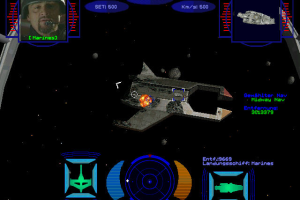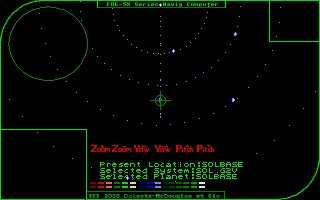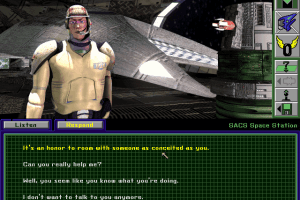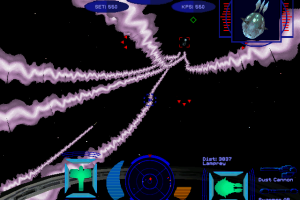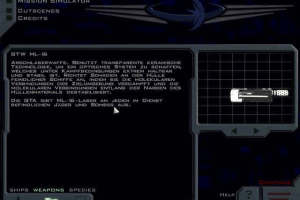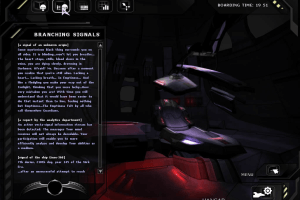Wing Commander: Prophecy
Windows - 1997
Description of Wing Commander: Prophecy
The Legacy
When I think of Wing Commander, the first image that springs to mind is not one of a scruffy, slightly-plump Mark Hamill parading around as Christopher Blair--far from it. I see myself strapped into a Hornet weaving through an asteroid field, dodging space rock left and right, engaged a deadly waltz with a wing of Dralthi. There always seemed to be a bogie on my six and my laser cannons never seemed to recharged fast enough for comfort--but it was a riot, and fond memories were in the making.
The Wing Commander series has come a long way since those glorious first battles I flew, and fans of the series have seen its transition to interactive movie status in the third installment bearing the Wing Commander name. Yet as the series took shape into the game that Chris Roberts wanted, I found that it became less of the game that I wanted. Oh sure, I was the first to greet the FMV with amicable naiveté, and to be honest, I still think that the Hollywood production elements have added to the game more than they have taken away. However, as was becoming increasingly clear--when the interactive movie is allowed to steal the spotlight from the space combat simulation, the gameplay suffers accordingly, and veterans of the game are alienated.
A Fresh Start, Footsteps to Follow
The game strikes a new beginning in the storyline of the Wing Commander universe. With Kilrath a fading memory, and Confed's border uprising under control, Prophecy gives Blair (now a Commodore and administrative paper-pusher) the official heave-ho from the cockpit, and introduces a fresh face for the game's main character. Meet Lt. Lance Casey, a rookie pilot riding blaze of glory out of the academy, and, as you WC trivia nuts may have already guessed from the surname, the son of WC1's Iceman. You don the persona of Lt. Casey as he enters his first assignment, aboard Confed's newly commissioned mega-carrier, TCS Midway.
The game also introduces a new enemy--a vicious insectoid race from the nether regions of the galaxy that has come in force to fulfill an ancient Kilrathi prophecy of death and destruction. Ruthless and deadly, the aliens with their advanced technology and vast numbers, embody the essence of darkness. And through the use of gratuitous amounts of dramatic license, the writers have conjured up an epic story that places the Midway as humanity's only line of defense against the alien armada, into a situation where a handful of pilots can overcome seemingly insurmountable odds to dispense peace, freedom, and justice to the galaxy. Yes indeed, it's Wing Commander alright, no doubt about it.
While Origin indicated that the focus of Prophecy was to be on gameplay, FMV is still very much an integral part into the game. An important part of the Wing Commander experience is the story telling, and Prophecy tries very hard to satisfy in this department. The manual does a good job of setting the tone, and introducing the merry crew of the Midway. The movie-style introductory clip is also well done, doing its part to instill a sense of awe and interest, and setting a foundation from which the plot can unfold. As you proceed through the game, video clips reveal more information about the mysterious alien race, and some character development takes place. Relationships build, pilots die, desperation swells, the hero triumphs--you know how it goes. However, while I thought that the game started off with great momentum, the grandeur and immersiveness of the story was stretched thin towards the end. This was mainly due to the fact that after the midpoint of the game, the life was really sucked out of the game. The bar where you arrive at after every mission to mingle with shipmates is rendered deserted, and as impressive as the killboard became, it kept poor company. Many loose ends are left dangling, and only FMV sequences provided were those essential to the development of the plot. As it stands, after you play out the third, and final, CD, part of you is still looking for the fourth.
The acting in Prophecy is good, but not the greatest. It is about as good as you can reasonably expect from a computer game, and on par with that of the preceding two games. The actor that plays Lt. Casey does a very good job adding dimension to the character, and really performs well, despite a script that breaks down here and there. The portrayal of Maestro, your happy-go-lucky academy buddy, and fellow rookie pilot is also well done, providing humor when needed. Series veterans Blair, Maniac, and Rachel are once again back along for the ride, although only Maniac seems truly comfortable in his role. Some other characters are tossed into the spotlight at various stages of the game, including Stilleto, the fiery First Lieutenant who steps aside for Lt. Casey to serve as wing commander, and Lt. Finley, the brainy science officer who tries to act flirtatious and sophisticated between gulps of replicated drink. However, neither of the two characters are developed much beyond their pretty faces, and the potential for interesting character interaction is wasted.
The new alien race is intriguing, but not much is revealed about them throughout the course of the game. For one thing, the game doesn't even offer a real reason for their brutal invasion of Confed and Kilrathi space. Most likely, Origin has greater plans for the aliens in future Wing Commander products. Appearance-wise the alien ships are dark and organic-looking--a sharp contrast to the sleek Confed designs. The aliens ships also introduce a new gimmick where several smaller ships join together to form a larger, more powerful vessel. For example, a trio of lighter fighters may physically join together to form a heavy attack ship armed with a devastating plasma gun. While simple concept, this trick it is very effective and I nearly did a double take when I saw it for the first time. It's amazing how fine details such as this help to give this game a lot of character.
In the Cockpit
The gameplay in Prophecy is Wing Commander at its best, and fans of the series will have little to complain about. However, having said that, don't expect any dramatic improvements either. One thing that I did notice though, is that the missions are now more closely scripted. While this provides for a smoother integration of the storytelling into the missions, it does feel somewhat restrictive at times. First off, you're no longer able to choose your own ship or weapon loadout before each mission. You are assigned the ship that has been deemed most appropriate for getting the job done, and usually you'll have nothing to complain about. Nevertheless, there were a couple of occasions when I would have given a left kidney for a different configuration, because I personally feel a lot more comfortable flying a craft with a bit of zip than a slug with few extra inches of armor. Also, within missions, the order in which you must complete your primary objectives is quite confined. For example, if you are given a mission with a series of objectives, you must usually complete them in the order given, even if it's something as simple as patrolling a couple of navpoints. Each mission also has a number of secondary objectives that you can try to pursue at your leisure. These mission objectives, and your kill count, is used at the end of each mission to calculate a percentile rating that gauges your performance for each flight. While I didn't find myself paying too much attention to the numbers, this scorecard does effectively appease vanity and debrief each mission in the same stroke.
More of the Same...
The missions themselves have changed very little, and the game cycles through the same standard set of mission types, including navpoint sweeps, escort, carrier defense, target strikes, etc. All in all, the mission selection is very much the same as what was first established in WC1, something when considered with a critical eye is not really the greatest of compliments. While Origin has worked hard to improved upon the audiovisuals at every step, little has been done to improve or enhance the game's mission structure or space-flight model. Nevertheless, one might argue that it is silly to tamper with perfection, and Prophecy does play extremely well. The whole theme of Wing Commander is about providing a immersive science-fiction environment to serve as the foundation for an arcade-oriented blast-em-up in space. There are few illusions of realism in terms of space-physics, and the sacrifices that are made, are for the sake of playability. With these objectives in mind, Prophecy delivers admirably. The combat is intense, and completely satisfying in bringing you the no-fuss, edge-of-the-seat combination of awe-inspiring audiovisuals and explosive action.
Living on the Edge
Combat is a livelier affair this time around with battles that are generally much larger. Instead of flying solo or with a lone wingman, the missions in Prophecy routinely teams you with an entire wing of Confed pilots. While it's still often a mere 6-10 ships against dozens of bogies, the odds are a bit more realistic, and the end result is a better portrayal a large-scale space battle, the likes of which you saw previously only in carrier-defense missions. However, despite improvement in friends-vs-foe ratio, it'll still usually be up to you to get the job done. This is especially true at the harder difficulty levels, where it's very much you versus the aliens, with your wingmen serving only a distractions to divert gunfire. But even, as showpieces, they are welcome company, and its often very amusing to listen to the jibes that they throw at each other, as well as the enemy ships during combat. Maestro and Maniac share some especially unforgettable exchanges, and add a lot of flavor to the missions.
Killing enemies is a very familiar affair, and if you've ever played a Wing Commander game, you'll feel right at home in the cockpit. The weapon selection is fairly unchanged, with a few exceptions, providing the standard assortment of guns and missiles. Some names have been changed here and there, but staples such as lasers and mass drivers are still around. The charging mass driver cannon adds a slightly different twist, and as the name implies, allows you to charge each shot with power dependent on the time you hold down the trigger. The Stormfire cannon also makes a reappearance, offering a gatling gun style fire output, at the expense of a limited number of rounds. The game also provides plasma weapons that have huge damage potentials, but extremely sluggish fire-rates. You need to be at extremely close range or be attacking a stationary target (i.e. capship turret) for the plasma cannon to be used effectively, but it only takes a couple of successful hits to terminate most enemy ships. The missile selection is also good, and you'll find the standard friend-or-foe, image recognition, heat seeking, and dumbfire flavors. Other familiar weapons include mines (which I still find difficult to use correctly), and torpedoes that are equipped on bombers as the only means of taking out capital ships. My favourite new weapon, though, is without a doubt the Swarmer missile. This weapon simultaneous fires out multiple projectiles which independently seek out and annihilate your target. They are visually impressive, and have the huge advantage of being unaffected by enemy decoys. My only complaint, but a loud one, is that they are only available in the Wasp fighter, which in turn is only launched in emergency scrambles to ward off enemy attacks on the Midway.
Dogfighting tactics are relatively unchanged, and the surest way to send an enemy bogie into the void is still to chase its tail and send a missile or two up its tailpipe. The key to survival is to keep moving and liberally use your ship's afterburners, because a good enemy AI will be extend you the same favours that you give them. You'll need to learn the best way to shake an enemy clamped to your tail, and the best time to release a decoy. This is especially true at the higher difficulty settings where missiles fly left and right, and missions are routinely fatal. Once you get a feel for the basics, there are also pretty simple tricks to learn, such as flanking enemy ships, and using rolling strafe-runs. More advanced players will no doubt have their own favorite tactics and styles of fighting, but as an action game, as long as you can line up targets to your reticle and pull a trigger, you'll see plenty of fireworks.
Managing your gun selection is quite important because if you stick to lasers, your enemies shields will regenerate faster than you can snipe it away. However if you use nothing for full guns all of the time, you'll soon run out of energy to support your high consumption. The key is to time your shots and to shoot in front of moving targets. Missiles are also extremely useful, but the enemies will usually dispose of your homing projectiles at the expenditure of a few decoys. Often I found that a couple of well placed dumbfire missiles or rockets will solve a problem with a lot less fuss than whole salvo of image recognition or some equivalent.
Capital ships in Prophecy are suitably impressive. The Midway itself is designed to be many times the size of any previous Confed carrier, and it is truly a awesome sight to behold from the cockpit, both in terms of beauty and shear size. Of course, the alien capital ships are similar behemoths, and no less impressive. Bristling with turrets that are actually dangerous, rather than pesky, they are actually a serious threat now, especially for slow moving bombers. The largest capships will also send missiles your way as you try to acquire a torpedo lock, making things even more difficult. In capship assault missions, bombers are especially vulnerable to both turret fire as well as vessel's fighter escort, so it's the job of fighters to take out enough of the turrets and enemy ships for the bombers to work in relative safety. Then the task breaks down into the systematic destruction of the capship's key systems--shield generators, engine, and bridge--usually in that order. Once this is done, the real show begins, and after a series of spectacular explosions the ship is consumed in a glorious fireball, leaving nothing but a burnt husk. Makes the whole business worth the trouble.
One feature that the game is missing, though, is the ability that allows you to fly inside the carriers. I really got a kick out of penetrating into an enemy carrier, turning on the autoslide, and blasting away entire squadrons of enemy ships before they even had a chance to launch. This is a surprising omission because the game's 3D engine obviously could have easily handled such an addition.
Casualties of War
One of the changes in Prophecy is the removal of a mission tree, giving the game a very linear feel. However, the tradeoff comes at the gain of one carefully sculptured mission path rather than a series of shorter diverging branches. While your performance in one mission will often have direct effect on the next, usually, as long as you (and your carrier) survive, you'll live to fight and win another day. Playing the game through the first time, I was desperately afraid that I had been thrown into a hopeless losing path after failing what I considered to be a key mission. However, this was not the case, as apparently, success in the subsequent missions quickly rectified my situation. While this helps maintain a constant pace of progress through the game, it also makes the game seem to be on the short side. I have heard many complaints that Prophecy is way too short, but the number of missions (around thirty) and average mission length is comparable to others in the series. But, whereas in previous games you might be stuck on a single mission for days at a time, Prophecy often allows you to chug along even if you fail a mission. This subtle difference has a drastic effect on the time it takes to play through the missions, and also on the overall longevity of the game.
One feature that is painfully missing from the game is multiplay of any sort. Multiplayer support had been promised from start, but in the end was sacrificed to allow the game to retail in time for Christmas 1997. Presently, Origin appears to in the process of completing a multiplayer upgrade that will be sold as part of an add-on package later this year. I for one, find that the decision to sell a feature that was originally promised for the game as a separate product completely disagreeable. Origin should offer the multiplayer package as a free upgrade, or in the least, only charge a trivia shipping and handling fee. In any case, this omission will be a major disappointment to the majority of Wing Commander fans, and for time being, X-Wing vs. Tie Fighter will still fly unchallenged in the realm of network and Internet play.
Continuing the Tradition, Setting the Limits
The game's graphics are a joy to behold. If you thought that the SVGA graphics introduced by WC3 were good then you'll be blown away by the game's 3Dfx enhanced graphics--I was. Few games released to date can compare with Prophecy's brilliant use of graphics effects, and only the likes of G-Police and Quake 2 are even in the same league. Everything from the rendered space backdrops to the exquisite coloured light effects help to give the game an almost cinematic quality during space-flight. The ship models are excellently done, and plenty of contours are used to eliminate polygon blockiness. The texturing is very good, delivering every last sliver of detail to the ships. Those of you who like big explosions will be especially pleased by the game's beautiful pyrotechnics. In addition to the classic fireballs, are explosions that yield clouds of coloured plasma, and also some that come in the form of mini-novas that expand in impressive-looking shockwave rings. Other small touches such as an improved shield-shimmer, realistic smoke trails left by missiles, lens-flare from bright stellar light sources also add to the stunning visuals.
Of course, if you don't have 3Dfx video card, there is a Direct3D mode to take advantage of, that offers most of the graphical features, and also a software mode that offers SVGA graphics that are improved upon WC3/4 . To fully enjoy Prophecy, however, you'll definitely need a good 3D accelerator. And if you aren't a owner of such a commodity, this game alone makes a strong case for you remedy that.
The Wing Commander series, and Origin games, in general has traditionally always excelled in the area of music and audio, and Prophecy does not break the trend. The mission music is excellent, and carries the mood very well. Special music tracks that were originally prepared for the multiplayer mode, and advertised in the official Prophecy audio CD soundtrack, are now tucked away in the training simulator. It almost seems wasted in the simulator, but would sound very out of place in the actual missions--no doubt we'll be hearing more of them once multiplay is enabled. The sound effects are of like-quality, and the game takes advantage of Dolby Surround Sound technology to provide true 3D sound support. However, you need to have a sound card that takes advantage of positional sound technology to fully enjoy the effect. I was unable to evaluate this feature with my no-frills Sound Blaster 16, but I guess as long as I don't know what I'm missing, I have nothing to miss.
The Verdict
The final impression of Prophecy that I wish to convey to you is a positive one. As Wing Commander 5, the game does well to keep the flame of the series lit, and once again brings the series to the edge of technology. While I have picked on the story, I must say that it was still enjoyable. The very fact that I considered the plot and characters one of the main features and worthy of thorough analysis, in an action no less, should tell you something about the standard of quality that Origin has set for itself. The FMV doesn't dominate, and it was never intended to. It had its shortcomings but despite that, is still a skip and a hop ahead of everything else. The graphics, as I have stressed are gorgeous, and probably are biggest selling point of the game. I had originally flirted with the idea of a Silver Award for the game because I was so taken away by the flawless graphics and solid gameplay. However, in the end, the lack of multiplay, in addition to the other minors faults that I mentioned, left the game just a far enough away from perfection to lose its claim to an accolade. For sure Prophecy is a good game, and if you're any kind of Wing Commander fan, I'd recommend that you rush out and buy it today. However, it is neither a revolutionary step forward, and with the release of I-War, nor the king of space combat simulation.
Review By GamesDomain
External links
Captures and Snapshots
Write a comment
Share your gamer memories, give useful links or comment anything you'd like. This game is no longer abandonware, we won't put it back online.
Buy Wing Commander: Prophecy
Wing Commander: Prophecy is available for a small price on the following website, and is no longer abandonware. GOG.com provides the best release and does not include DRM, please buy from them! You can read our online store guide .
Similar games
Fellow retro gamers also downloaded these games:









